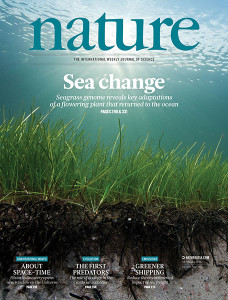Genome gives insight to extreme genetic plant adaptations
Huntsville, Ala. — Three researchers from the HudsonAlpha Institute for Biotechnology successfully performed DNA sequencing on a new plant genome, Zostera – an eelgrass that is the first of its kind to be sequenced. The work was part of a six-year project with the Department of Energy Joint Genome Institute (DOE JGI) that could help researchers understand how plants adapt to extreme environmental changes. The results of the project were published online in Nature on January 27.
 Jeremy Schmutz, a faculty investigator at HudsonAlpha and a co-director of the HudsonAlpha Genome Sequencing Center, called the project “difficult to work on from a genomic side.” His colleagues at HudsonAlpha who worked on the sequencing include GSC co-director Jane Grimwood, Phd, and Jerry Jenkins, the Genome Analysis Group Leader at the GSC. The group used several technologies and worked on two different plant samples – one of which was 20 feet long – in order to complete the sequence.
Jeremy Schmutz, a faculty investigator at HudsonAlpha and a co-director of the HudsonAlpha Genome Sequencing Center, called the project “difficult to work on from a genomic side.” His colleagues at HudsonAlpha who worked on the sequencing include GSC co-director Jane Grimwood, Phd, and Jerry Jenkins, the Genome Analysis Group Leader at the GSC. The group used several technologies and worked on two different plant samples – one of which was 20 feet long – in order to complete the sequence.
“Zostera is 140 million years diverged from the most recent ancestor to which we could compare its genome, and since the plant can’t be cultivated in a lab, we had limited options for what we could use for the sequence,” Schmutz said. “We’re pleased that our colleagues were able to use the results in such an important way.”
Eelgrass is a completely submerged marine flowering plant that is not technically a grass at all. Its texture is like kelp, but it was once a flowering land plant that evolved over millions of years to become an ocean-dwelling seagrass.
By comparing the eelgrass genome with the freshwater plant duckweed – also sequenced at HudsonAlpha in collaboration with DOE JGI – the research team was able to identify genetic changes that allowed the plant to adapt from a land species to eventually thrive in a harsh, turbulent saltwater environment.
Study lead author Jeanine Olsen, PhD, of the University of Groningen in the Netherlands called this shift “arguably the most extreme adaptation a terrestrial (and even a freshwater) species can undergo.” Following what she describes as the “use it, lose it or change it” scenario, genetic modifications adjusted how eelgrass collects light, defends itself against pests, pollinates and regulates its internal water balance in saltwater.
Identifying and understanding those genetic adaptations are significant for monitoring seagrass populations world-wide. The seaside ecosystems where eelgrass grows cover some 200,000 square kilometers – an area about the size of Alabama and West Virginia combined. These marine plant systems are valuable ecologically because of the coastal protection they provide, the nurseries of young fish and other organisms they support and the role they play in carbon and nutrient cycling.
Schmutz, who is also the head of the DOE JGI’s Plant Program, emphasized that while eelgrasses are key players in coastal marine ecosystem functions and considered the “lungs of the sea,” they are also endangered. “There are estimates that nearly a third of the eelgrass meadows worldwide have been destroyed by runoff into the ocean,” he said, “reducing their potential capabilities as carbon sinks. Thus, studying the adaptive capacity of eelgrass is urgent to assist conservation efforts.”
About the Genome Sequencing Center: The Genome Sequencing Center (GSC) produces, analyzes and interprets genomic data on economically important species to improve crop breeding and other agricultural practices. Co-directed by Jane Grimwood, PhD, and Jeremy Schmutz, the GSC is one of the few centers in the world performing de novo sequencing of complex plant genomes. The center has sequenced over 100 species and is focused on genomes related to food production and renewable biofuel research. Research at the GSC in the field of bioenergy supports initiatives related to clean energy generation, improving biomass yield and the efficiencies of processes used to convert plant materials into liquid fuels. To learn more about the Genome Sequencing Center, visit: http://www.hagsc.org/.
About HudsonAlpha: HudsonAlpha Institute for Biotechnology is a nonprofit institute dedicated to innovating in the field of genomic technology and sciences across a spectrum of biological challenges. Founded in 2008, its mission is four-fold: sparking scientific discoveries that can impact human health and well-being; bringing genomic medicine into clinical care; fostering life sciences entrepreneurship and business growth; and encouraging the creation of a genomics-literate workforce and society. The HudsonAlpha biotechnology campus consists of 152 acres nestled within Cummings Research Park, the nation’s second largest research park. Designed to be a hothouse of biotech economic development, HudsonAlpha’s state-of-the-art facilities co-locate nonprofit scientific researchers with entrepreneurs and educators. The relationships formed on the HudsonAlpha campus encourage collaborations that produce advances in medicine and agriculture. Under the leadership of Dr. Richard M. Myers, a key collaborator on the Human Genome Project, HudsonAlpha has become a national and international leader in genetics and genomics research and biotech education, and includes 30 diverse biotech companies on campus. To learn more about HudsonAlpha, visit: http://hudsonalpha.org/.
HudsonAlpha Media Contact:
Margetta Thomas
mthomas@hudsonalpha.org
256-327-0425


